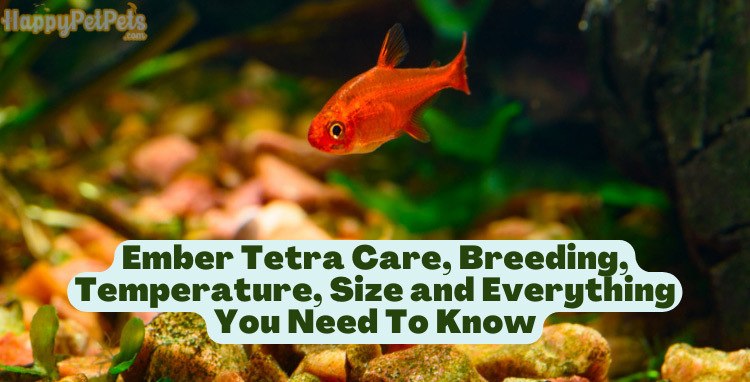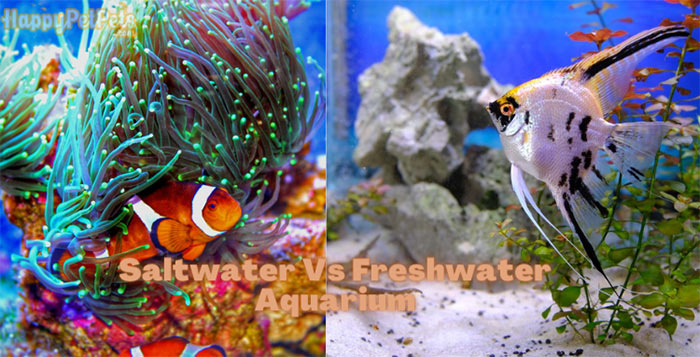If you are keeping some fish as your pet, you must know how dangerous it is when ammonia level in your fish tank is higher than needed. This article will show you how to reduce ammonia in fish tank in the best and easiest way.
What You Need To Know About Ammonia In A Fish Tank
1. What is ammonia

Form of ammonia (NH3)
Ammonia, usually known as formula NH3, is a chemical that is harmful to your fish. The bad news is every fish tank can produce ammonia naturally.
If you ask for “Why does my fish tank stink”, the fish tank smells bad due to the typical stink of ammonia.
Ammonia comes from:
- Dead fish
- Dirt from the filter
- Dead algae and plants
- Fish breathing and waste
- Fish food leftover in the tank
2. How can ammonia affect the fish
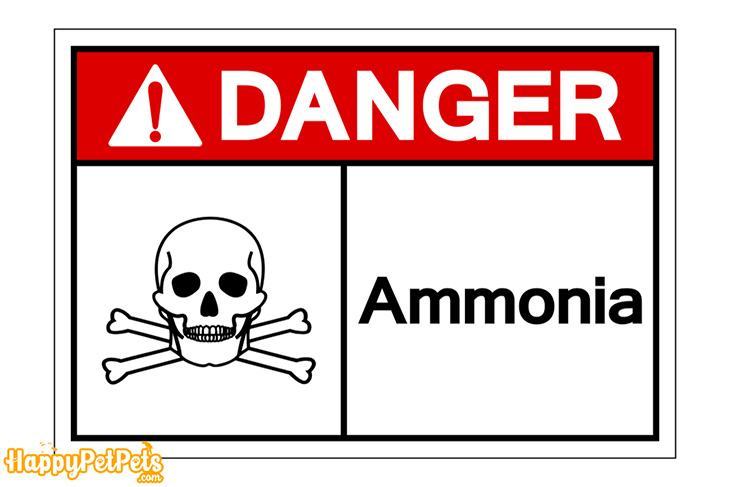
Ammonia at a high level can cause death to the fish
First, ammonia takes more space in the aquarium water. This means the more ammonia in the fish tank, the less oxygen for the fish.
Then, ammonia can cause ‘ammonia stress’ and ‘ammonia poisoning’ to the fish and other aquatic species in the aquarium.
Ammonia stress is a threat that happens because of the replacement of oxygen with ammonia, and its high level in the tank, which makes more side effects on the fish.
Fish and all the aquatic species, including biological filter (good bacterias and other microorganisms) can be stress, be affected and start to get sick easier, also the organ might not work as good as it used to be anymore.
When this ammonia stress leads to death, it becomes ammonia poisoning.
3. What should ammonia level be in fish tank
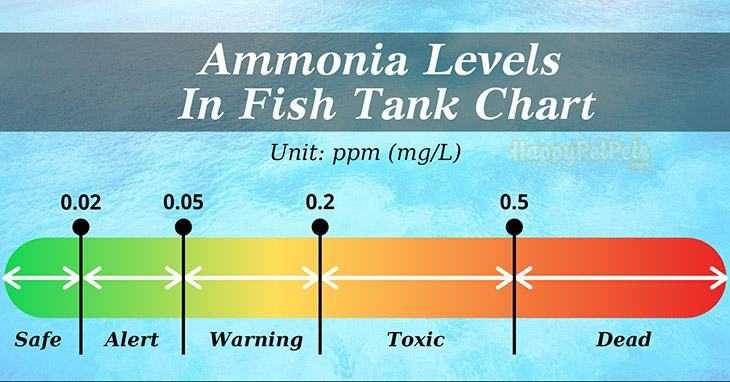
Ammonia levels in fish tank chart
The safest level of ammonia in a fish tank should be 0 ppm (parts per million), but ammonia in fish tank how to get rid of it completely is quite impossible to do, so the only thing you can do is keeping it as close to nonexistent as possible.
You should follow this “Ammonia levels in fish tank chart” to find which level is safe or not safe for you fish.
Ammonia level in the fish tank is considered as:
- Safe: from 0.001 to 0.02 mg/L
- Alert: from 0.02 to 0.05 mg/L
- Warning: from 0.05 to 0.2 mg/L
- Toxic: from 0.2 to 0.5 mg/L
- Dead: more than 0.5 mg/L
4. What causes ammonia in fish tanks to rise high
There will be an ammonia spike in the fish tank if:
- The fish is overfeeding
- Do not clean the tank regularly
- There are not enough good bacteria
- More fish than required of the tank volume
- The filter is not working efficiently as expected
5. What are signs of ammonia in fish tank being at a high level
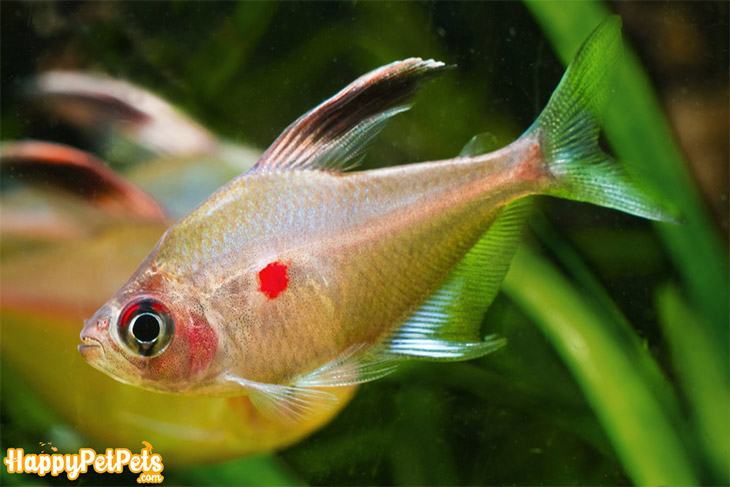
Red striking on the fin is a symptom of fish be affected by ammonia poisoning
The high-level ammonia in fish tank symptoms are:
- Your fish start turning red, purple or bleeding
- Your fish have fin-clamped and lose their appetite
- Your fish get slower and easy to suffer from irritation
- Your fish stay at the bottom and come to the top to breathe
- Your fish die
How to reduce ammonia in fish tank
Part 1: Conducting some ammonia testers
1. How To Check Ammonia Levels In Fish Tank Without Kit
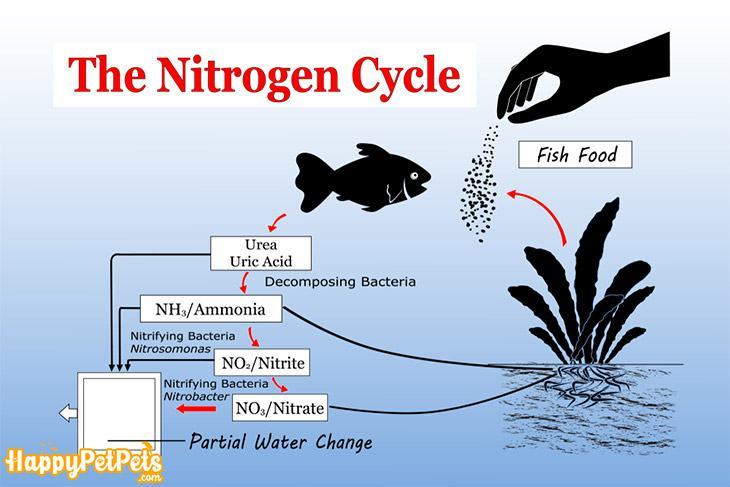
The nitrogen cycle is the basic thing that affects the ammonium level in the aquarium
You probably don’t have ammonia testing kits available every single time you need them. Hence, you should know how to check ammonia levels in fish tank without kit to get through this situation.
In this case, the only thing you can do is checking the ammonia in fish tank symptoms, which is usually based on the nitrogen cycle.Watch the fish and your aquarium water carefully. In general, when a nitrogen cycle starts happening, your fish tank water might not transparent, but it will clarify when this cycle is working correctly.
Then, take a closer look at the fish: are they swimming slowlier, having red gills or lacking appetite, any similar symptoms as what we have discussed above. If they have, then your ammonia level in the fish tank is out of the safe area.
2. Using Ammonia Testing Kits
Of course, you can check the ammonia in fish tank symptoms by eyes, but the usage of ammonia testing kits is more needed since it can give you the result easier and faster.
In most cases, people used to miss the symptoms, and they only aware of an ammonia spike when the tank starts having dead fish.
Most of the pet stores can offer ammonia testing kits. These kits usually include pH, nitrites and nitrates testing along with ammonia.
3. How to check ammonia levels in fish tank with a kit
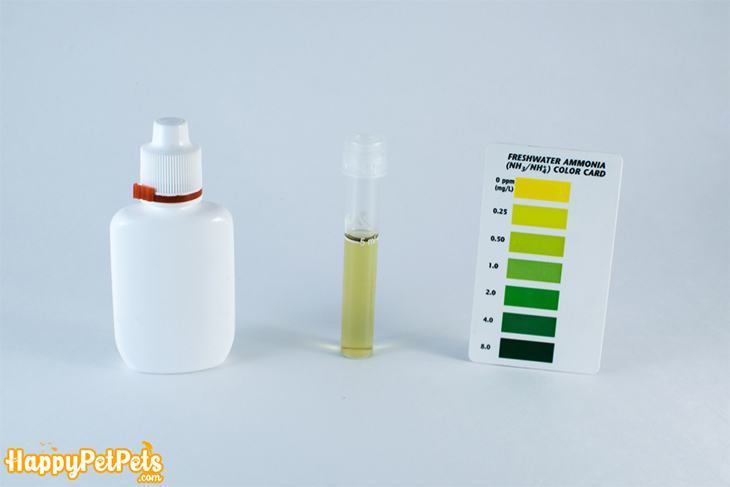
Basic elements of ammonia testing kits
Preparation:
- An ammonia testing kit
- Time to check: Test first – feed later. The new food can break down quickly in the water so that it may give you an inaccurate result. Besides, the ammonia level will be on its edge about 90 minutes after feeding.
Performing:
- Put some of your aquarium water into the given tube
- Add a few drops of testing solution
- Lightly shake the tube and wait until it changes the colour
- Compare the water’s colour with a colour level chart of the kit to check the ammonia rate
Part 2: Find out the cause of high ammonia level

Uneaten food is a cause of high ammonia level in the fish tank
When you know the reason, you can fix the problem directly with an exact solution.
The typical causes of high ammonia level are:
- Your tap water quality: Your tap water usually is examined about the chemical level to ensure it is safe to use. But it’s worth to check one more time for you and your fish safety by using an ammonia test kit
- Level of rotten organic in the tank: Fish food, aquatic plants and microorganisms can affect the ammonia level in your fish tank
- The fish naturally produce too much ammonia: It is the reason “why are my fish at the top of the tank”. They need to go up high for more fresh space
Part 3: How to reduce ammonia level in fish tank with five steps
Preparation:
- New freshwater
- Dechlorinating, pH, ammonia removal solutions
- Scraping tools
- A siphon tube
- Ammonia testing kits
Step 1: Change the fish tank water partially
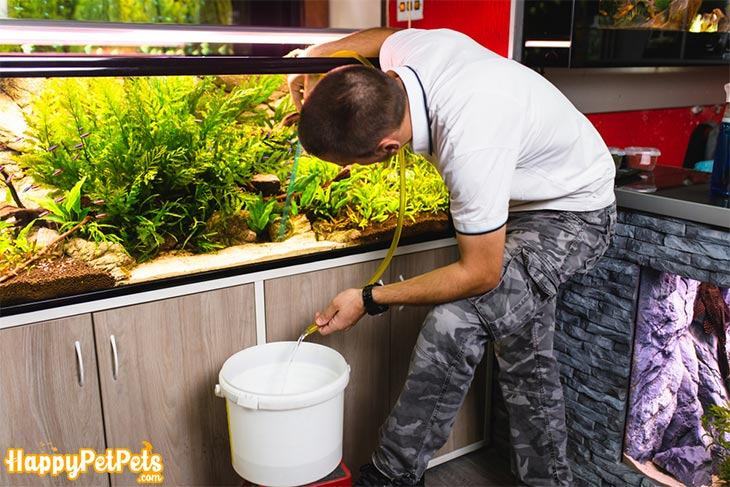
Using a siphon tube to make a partial water change
You should not let the entire water get out of the tank because it may have enough useful elements for the fish to live. Make a partial change can keep the good things in while maintaining the water cleanliness.The partial water change should happen once a week, or more based on how your fish tank be. To know if you have made enough water changing, you can stir the settled gravel to see the debris status. If there is a lot of debris floats up in the water, that means you should change a partial water a few more times.Usually, it needs to change 20-30% of the tank water, but if the ammonia level is quite high, you can do it up to 50% of the entire water in your aquarium.
- Prepare a fresh, dechlorinated water. You can let the freshwater sit outside or support it with a drop of dechlorinating solution
- Remove all the contaminations that available on your hands like condition cream, soap, etc. and dry them with tissues
- Unplug any electric appliances around the fish tank. Make sure to connect the power only when you finish the water change, and everything is dry
- The fish don’t need to get out of the tank, just don’t scare them while you are changing the fish tank water
- Get rid of the algae that might appear on the tank walls. You can use a specialized tool so scrape it. A credit card may work with the algae as well
- Use a siphon tube to transfer 20-30% of old water into a bucket, then put the new freshwater you have prepared slowly into the tank
Step 2: Improve water quality and cleanliness
As you know, the ammonia level can get higher due to the organic waste left in the water, so you should eliminate all those unnecessaries to reach a better water condition for your fish.
- Use a fish net to lift all the dead plants, excess food, fish waste, anything but living fish and aquarium plants that are not good for the fish, out of the fish tank
- Take out every dead fish to not let them affect the others
- Clean the filter to prevent it from putting back the waste
- Remove the debris that sticks with the tank gravel
Step 3: Changing the feeding frequency
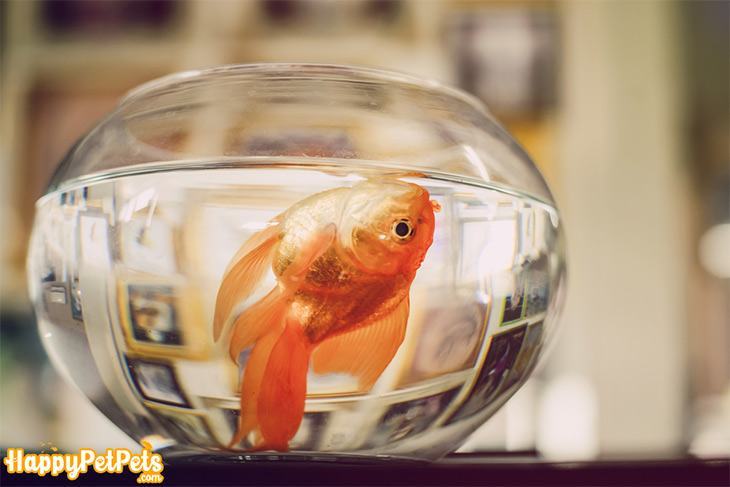
Lots of fish die because of ammonia poisoning or overeating
With every fish raising beginners, they usually feed the fish too much. More food than required can cause death to the fish because of overeating or the high level of ammonia in the tank that might stress the fish.
As I mentioned before, “How do I prevent ammonia poisoning in my fish tank” is basically a way to do not let the fish die due to ammonia stress. And performing a suitable feeding frequency is undoubtedly the best way to limit this threat for your fish.Try to search for the number of time, and the quantity of food should use for your types of fish and follow it.
Step 4: Upgrade the fish tank water condition
To prepare a better living condition for your fish, do as the steps below:1. Add more good bacteria to the water:Healthy bacteria usually is Nitrosomonas and Nitrobacter in detail, are the good bacteria that take part in the nitrogen cycle and help to break down the ammonia into better compounds. The final compound can easily get out of the tank through water change.The problem with good bacteria may happen when you change the whole water. New water will have the same condition with a new fish tank, don’t have enough healthy bacteria and nitrogen cycle, lead to a high level of ammonia and later is more fish died after water change.You can add more good bacteria to the water by add in some fish or gravel from the old fish tank to reuse the bacteria needed that already exist.
❝
Tips
How to lower ammonia levels in saltwater tank with the fish add-in? With the solution of using other fish to bring along the good bacteria, with a saltwater tank, you can add 1 or 2 damselfish. Its waste can help with providing more healthy bacteria.
Similarly, with a cold water tank, you can use goldfish. Barbs will work well for a warm aquarium.
2. Provide the aeration and aquatic plants for the water:You can buy an aeration pump to pushing the ammonia gas diffusion. More ammonia can be pushed out faster, which is great for ammonia removal from water. Don’t forget to take off the tank cover to get the best result.
❝
Tips
Do aquarium plants help with ammonia? The aquatic plants can help produce more oxygen for the fish while absorbing carbonate (CO2) and ammonia produced in the tank, which is really good for the fish living condition and help reduce the NH3 level naturally.
3. Lower the pH level of your fish tank:If the pH level is basic (higher than 7 in the pH scale), it can concentrate more NH3, ammonia, which is toxic to your fish.You can lower the pH level easily using the pH solution. It can drop down the pH level quickly. Although lowering the pH level cannot cut down the ammonia in the tank, it still reduces the risk if you can’t change the water when needed.Besides, you should not set the bottom of your fish tank with kinds of coral, in the form of crushed powder or sand, because it can produce calcium, which makes the pH level go up high.4. Use other chemicals to helpIf the ammonia level is in an emergency, using ammonia remover, a type of ammonia removal from water solution like Fluval ammonia removal for help.This chemical can fix the problem quickly, but you should choose it as a temporary solution and only in a must-use situation.Another way to help is by using an ammonia neutralizer aquarium. This neutralizer cannot get rid of the ammonia, but it can reduce the toxic effects of ammonia, which is an effective temporary solution for the tank. If the pH level is basic
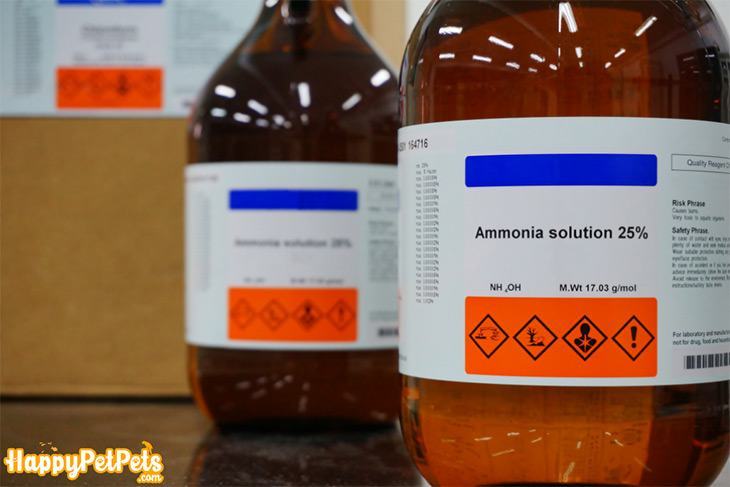
Ammonia solution is a temporary way to control the ammonia level in the fish tank
Step 5: Control the fish quantity and water quality
Sometimes, you might add too many fish, and add continuously that the good bacteria performance cannot catch up with the fish waste, and results in a high level of ammonia.
You should put in a suitable quantity to let the fish have enough space with your tank size and then change the water regularly to keep it clean as needed.In addition, don’t forget to ensure the proper temperature for the fish. Check how to tell if aquarium heater is broken or how to keep a fish tank warm without heater to save you in an emergency, and help to maintain the water quality for your fish.
Let’s see how to reduce ammonia in fish tank with a test kit
Conclusion
Except for the chemical usage, all the solutions above are the best answer for “How do I get rid of ammonia in my fish tank naturally”. The most important things for naturally prevent ammonia poisoning are feed the fish enough, choose the right quantity and create the biological filter.
The high level of ammonia in the fish tank is truly dangerous. How to reduce ammonia in fish tank only needs five steps and effortless to do, so you can try these steps more frequently to keep the fish in the best environment, reduce all the risk that might happen to your fish. Don’t wait until the fish died to fix the problem because your fish deserve better things.
Please share and comment on this post if you find it helpful. In case you have a better solution or need more help, don’t be shy to message us, we will reply as soon as possible.
Related keywords:
how to lower ammonia in fish tank, how to lower ammonia levels in fish tank naturally, how to get rid of ammonia in fish tank, how to lower ammonia levels in fish tank, how to remove ammonia from fish tank, how to control ammonia in fish tank, how to reduce ammonia in aquarium, how to fix ammonia levels in fish tank, how to reduce ammonia in fish tank naturally, how to decrease ammonia levels in fish tank, how to prevent ammonia in fish tank, how to reduce ammonia levels in fish tank, how to reduce ammonia in a fish tank, how to get ammonia out of fish tank, reducing ammonia in fish tank, how to fix ammonia in fish tank, how to lower ammonia in aquarium, how to remove ammonia from fish tank naturally, how to keep ammonia levels down in fish tank, how high can ammonia levels go before death
Similar Posts: https://happypetpets.com/category/aquariums-accessories/fish-tanks/
Source: https://happypetpets.com/



